Once again in an attempt to learn how to store food without canning or freezing so as to further separate from our dependence on the world, I thought it would be interesting to try to make apple cider vinegar, for the preserving method, for the health benefits, and since we have several apple trees in our orchard.
The recipes on the Internet basically said squeeze the apples for the juice, add a little already-made apple cider vinegar that has “the mother” in it, and let it sit for 3 to 4 weeks. Some said to add yeast, but I was trying to use as few outside ingredients letting creation and the yeast that is naturally in the air handle it. It apparently ferments and then turns to vinegar.
And so we purchased some apples and used our lard press on them. One apple cut in half with the halves face down seemed to press the best:
Here I am pressing:
And here are the results:
This is what was left after pressing:
(On a side note, sadly, the cast iron plate of the lard press cracked in half, I guess from tightening too hard; so, using it wasn’t a great idea. I suppose we might have to try a cider press for future attempts.)
After we were done pressing, Sue poured the juice through a piece of paper towel (as a filter) into the non-metallic containers (because of the acid produced) where they would ferment, and so we used canning jars. The first time, it took about 6 pounds of apples to make two 2/3 pint jars full; the second time we got 5 pints from 9 pounds:
Sue then added a couple of table spoons of already-made apple cider vinegar to act as a “starter”. From there they sat for several weeks. Each day I would tighten the caps, shake the jars and loosen the caps again to allow for any pressure out and some more air (with yeast hopefully) in.
After 6 weeks, the alcohol didn’t seem to be dissipating very quickly, and Sue did a little more research, and she discovered we probably should have just covered the jars with cheese cloth or a towel. I had figured it didn’t really matter much as long as some air was getting in there, but apparently it needs constant air availability.
And indeed it did what it was supposed to do: the apple juice is now vinegar!
We marvel at the Lord’s workings in His creation and how He has included these things to help us in the temporal matters of sustenance, and we thank Him for these provisions.
— David
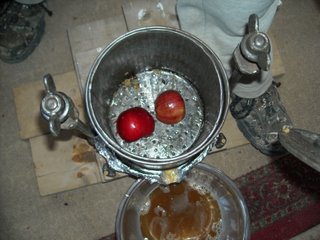
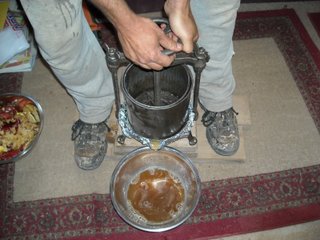
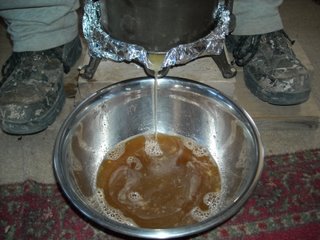
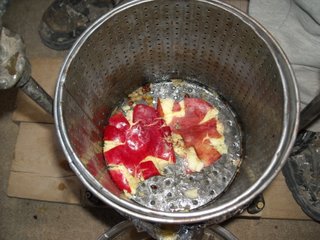
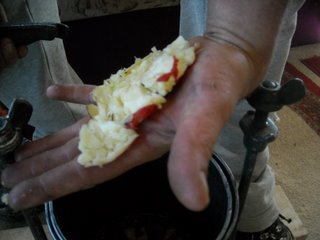
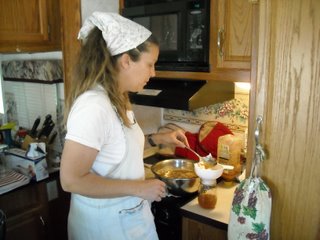
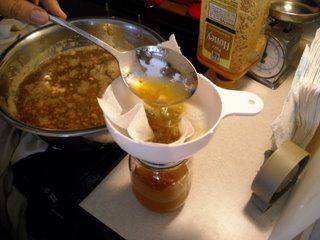
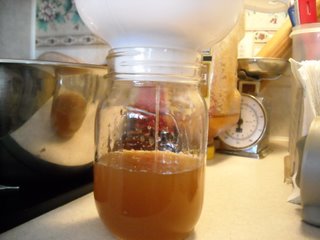
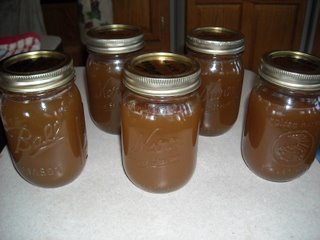
David and Susan,
Good first try at Apple cidar vinegar. I’ve not personnally done this yet, but I bet Karen has.
As you probably know, I gave the community that manual tomato separator last fall. I wondered if it could help in making either Apple juice or vinegar. It appears it could at least make applesauce. It says on the site
http://www.pleasanthillgrain.com/
tomato_strainer.aspx
that the apples should be peeled/cored/cooked, so probably not for raw vinegar. The above site with (com/fruit_press.aspx) at end, and the site listed below both have neat cidar presses. Perhaps you’ve seen them. They emphasize fruit has to be totally bug and blemish free to be safe which is a challenge in a home orchard, without chemicals!
http://www.HomeCidarPress.com
Did you use Braggs raw cidar vinegar with the “mother” in it to start your vinegar? I have that in my cupbd. Thanks for sharing!
Beth
Hi Beth,
Thank you for the links and info. Some people pasteurize their vinegar; we wanted to keep it as pure/raw as possible.
I think long-term we’ll have to have a cider press or something similar because the cast iron plate at the bottom of the lard press broke because I twisted it too hard (I’ll probably add that info to the original post).
And yes, Braggs with the mother was what we put in it.
Thanks again,
— David
I use wild plums and/or the peelings and pits from canning peaches to make wine vinegar. They say the agerita berries make good wine, I’d bet the vinegar would be good as well. David suggested that if you replace the plate on the lard press that you might try using a circular piece of wood underneath it (the wood pressing directly on the fruit) to disperse the pressure. He thought that might be the reason it broke.
Hi Judy,
Thanks for the other-fruit and press suggestions. I think I’m going to try to have the plate welded back together, and then maybe we’ll try using the wood piece.
Thanks again,
— David
Very cool, Will have to get one of Herrick Kimball’s whiz bang apple thing a ma jigs… you know? Now for some apple cider, apple wine, apple sauce… etc.
Debylin